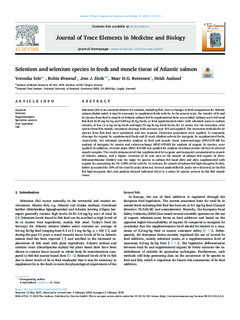| dc.description.abstract | Selenium (Se) is an essential element for animals, including fish. Due to changes in feed composition for Atlantic salmon (Salmo salar), it may be necessary to supplement feeds with Se. In the present work, the transfer of Se and Se species from feed to muscle of Atlantic salmon fed Se supplemented diets was studied. Salmon were fed basal fish feed (0.35 mg Se/kg and 0.89 mg Se/kg feed), or feed supplemented either with selenised yeast or sodium selenite, at low (1–2 mg Se/kg feed) and high (15 mg Se/kg feed) levels, for 12 weeks. For the extraction of Se species from fish muscle, enzymatic cleavage with protease type XIV was applied. The extraction methods for Se species from fish feed were optimised, and two separate extraction procedures were applied, 1) enzymatic cleavage for organic Se supplemented feeds and 2) weak alkaline solvent for inorganic Se supplemented feeds, respectively. For selenium speciation analysis in feed and muscle tissue anion-exchange HPLC-ICP-MS for analysis of inorganic Se species and cation-exchange HPLC-ICP-MS for analysis of organic Se species, were applied. In addition, reversed phase HPLC-ICP-MS was applied for analysis of selenocysteine (SeCys) in selected muscle samples. The results demonstrated that supplemented Se (organic and inorganic) accumulated in muscle of Atlantic salmon, and a higher retention of Se was seen in the muscle of salmon fed organic Se diets. Selenomethionine (SeMet) was the major Se species in salmon fed basal diets and diets supplemented with organic Se, accounting for 91–118% of the total Se. In contrast, for muscle of salmon fed high inorganic Se diet, SeMet accounted for 30% of the total Se peaks detected. Several unidentified Se peaks were detected, in the fish fed high inorganic diet, and analysis showed indicated SeCys is a minor Se species present in this fish muscle tissue. | nb_NO |
